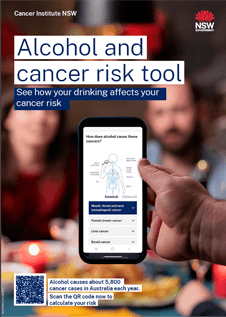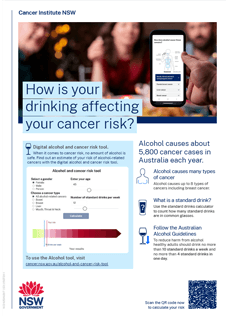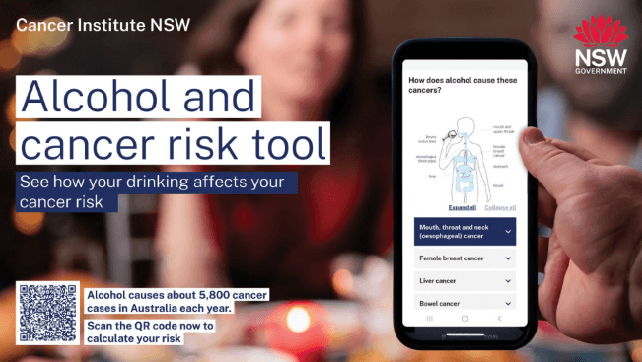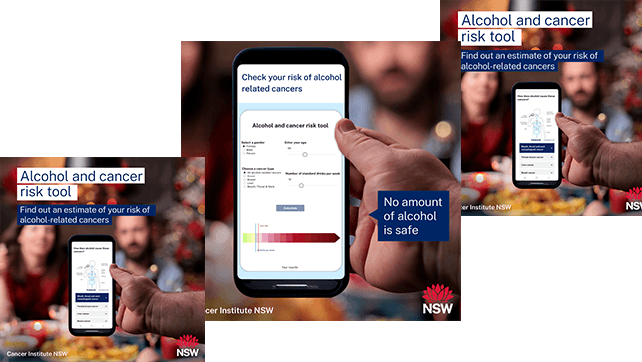Alcohol and cancer risk tool
We appreciate your suggestions to help improve our content.
Some things that cause cancer can't be changed, like age and family history. But there are other things, like drinking alcohol and living a healthy life, that you can control. Our Alcohol and cancer risk tool helps you understand how your alcohol intake affects your risk of cancer.
Check your alcohol and cancer risk
The information presented in this tool shows the likelihood of developing alcohol related cancer during your lifetime that is due to your level of alcohol intake. Higher levels of drinking over time increase a person's alcohol-related cancer risk.
Alcohol and cancer risk tool
Alcohol and cancer risk tool
Disclaimer: Alcohol-related breast cancer risk was calculated for females. The data is not available for people who select ‘male’ or ‘person’. The age on the Tool starts at 25 years due to a 10-year lag time between exposure to alcohol consumption and cancer risk. Contact the Cancer Institute NSW for more information.
This tool is for educational purposes only and is not intended for clinical use. It is not suitable for people under 18 years or people who are pregnant or trying to become pregnant.
What is a standard drink?
Use the standard drinks calculator to count how many standard drinks are in common glasses.
Full strength

1.1
285 mL (middy)
4.8% Alc. Vol

1.6
425 mL (schooner)
4.8% Alc. Vol

1.4
375 mL
4.8% Alc. Vol

1.4
375 mL
4.8% Alc. Vol
Average serving size

1.6
150 mL
Red wine
13.5% Alc. Vol

1.4
150 mL
White wine
11.5% Alc. Vol

1.4
150 mL
Sparkling wine
12% Alc. Vol

6– to 8
750 mL
Bottle of wine
11– to 13% Alc. Vol

1
30 mL
Straight spirit
40% Alc. Vol

1.2
330 mL
Pre-mixed spirit
5% Alc. Vol

1.5
375 mL
Pre-mixed spirit
5% Alc. Vol
Alcohol causes many types of cancer
Alcohol contains ethanol, a Group 1 carcinogen. When the body breaks down ethanol, it turns into acetaldehyde, a toxic chemical that can damage the DNA of your cells – leading to cancer.
Even small amounts of alcohol can increase your cancer risk. If you choose to drink, staying within the Australian Alcohol Guidelines of no more than 10 standard drinks a week and no more that 4 standard drinks a day can reduce harm from alcohol.
How does alcohol cause these cancers?
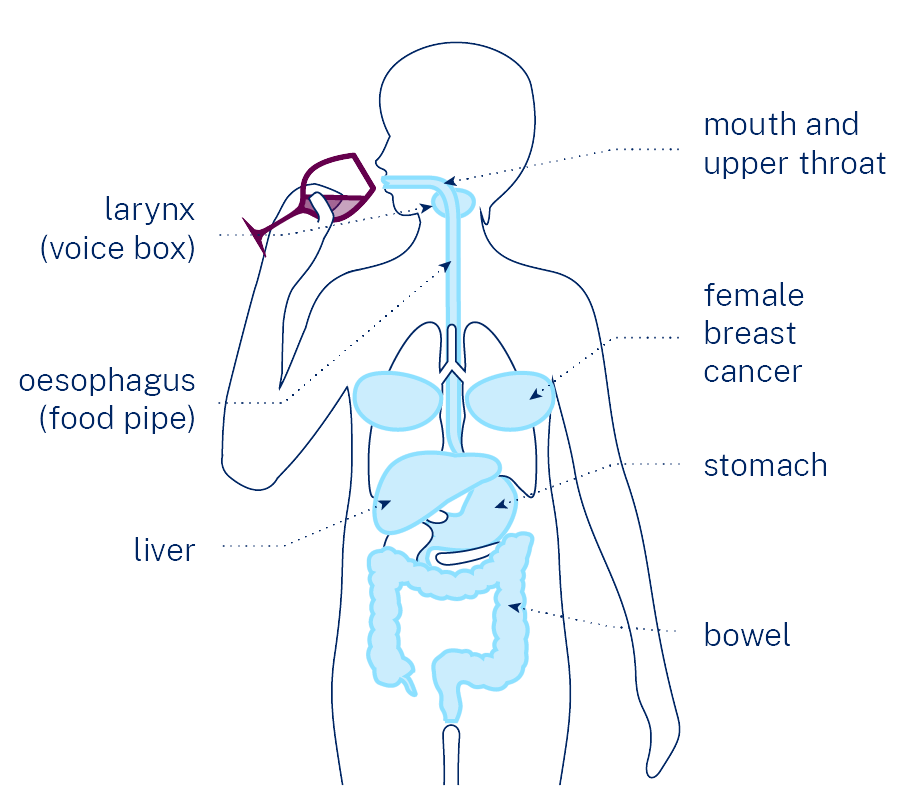
Alcohol can damage cells in the mouth and throat. This makes it easier for harmful chemicals to go into the body. If you drink alcohol or smoke tobacco, your risk of mouth, throat and oesophageal cancers increases. When you drink alcohol and smoke tobacco together, the combined risk is much higher.
Alcohol is a modifiable risk factor for breast cancer in women. Alcohol can damage the DNA in cells, and in women can increase levels of oestrogen, affecting the regulation of breast tissue. This increases the risk of breast cancer.
Alcohol is processed in the liver. The more alcohol that’s consumed the harder the liver needs to work, in the process damaging cells. Over time this can lead to cirrhosis (severe scarring of the liver), which is a major cause of liver cancer.
As alcohol is broken down by the body, it can damage the DNA in cells in the colon and rectum. This damage can lead to bowel cancer.
Tips to drink less alcohol
For more information and help to drink less or stop drinking:
See practical tips to lower your cancer risk from alcohol
Find a free alcohol support service in our list of alcohol contacts
Call the Alcohol & Drug Information Service (ADIS) hotline on 1800 250 015 for advice and support.
Important note:
For some people, suddenly stopping drinking can make them feel physically and emotionally unwell. If you feel sick, sweaty or cannot sleep when trying to cut down on your drinking – you may be experiencing withdrawal symptoms and should see your doctor. If in doubt don’t stop drinking but seek medical advice.
Australian Alcohol Guidelines
The Australian Alcohol Guidelines aim to reduce health risks from drinking alcohol by providing advice so people can make an informed decision about their alcohol consumption. Following these guidelines can lower the risk of harm, but it cannot remove the risk completely.
People under 18 years of age and women who are pregnant or breastfeeding should not drink alcohol to prevent harm to themselves, their unborn child or baby.
Healthy adults should drink no more than:
- 10 standard drinks a week

- 4 standard drinks in one day

More information and helpful resources
The Daffodil Centre, a joint research partnership between the University of Sydney and the Cancer Council NSW.
How was this data calculated?
Reference: Sarich P, Canfell K, Egger S, Banks E, Joshy G, Grogan P, Weber MF. Alcohol consumption, drinking patterns and cancer incidence in an Australian cohort of 226,162 participants aged 45 years and over. Br J Cancer. 2021 Jan;124(2):513-523.
Data sources used in the data analysis are the 45 and Up Study, NSW Cancer Registry and the NSW Registry of Births, Deaths and Marriages. The data custodians are Sax Institute, NSW Ministry of Health and Cancer Institute NSW
Contact us for more information on the data source and analysis: CINSW-Prevention@health.nsw.gov.au
